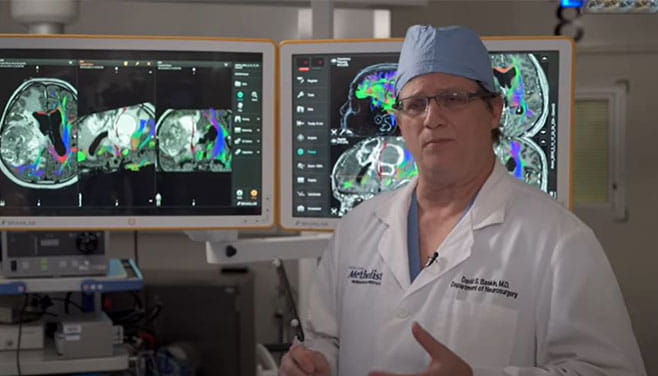Stereotactic Radiosurgery & Radiation Therapy
FOR MORE INFORMATION OR TO SCHEDULE AN APPOINTMENT346.238.5333
OUTSIDE HOUSTON877.790.3627
INTERNATIONAL1.713.441.2340
Find a Brain Tumor Specialist Near You
Houston Methodist’s neurosurgeons use the latest stereotactic radiosurgery and radiation therapy technologies to selectively attack brain tumors — even tumors previously considered untreatable.
Houston Methodist neurologists offer the most advanced stereotactic radiosurgery (SRS) and radiation therapies. These advanced treatments use focused beams of radiation — directed to the precise shape and location of the tumor — to shrink and eliminate the cancer while safely passing through healthy brain tissue.
Radiation therapy, or radiotherapy, uses high-energy beams (X-rays or gamma rays, for example) to kill tumor cells and keep tumors from growing. Radiation can be targeted to reach the brain tumor without affecting other parts of the body, and may be used before, after or instead of surgery, depending on each patient’s situation. Some treatment plans will also include chemotherapy.
SRS often is a successful treatment option for patients with remaining lesions after brain surgery, or for those who have tumors in critical brain regions that cannot be safely accessed with conventional surgery.
Highly efficient for primary and metastatic tumors, most patients can receive one-time SRS therapy or a short course of 3 to 5 treatmen ts — instead of the usual 20 to 26 treatments — with fewer side effects than traditional radiation therapy. Advanced radiation therapy offers patients the potential for longer, higher quality lives.
Specialized Stereotactic Radiosurgery Equipment
Neurosurgeons and radiation oncologists at Houston Methodist Hospital Stereotactic Radiosurgery Program use highly specialized stereotactic radiosurgery equipment, such as the Gamma Knife and Novalis®.
Our surgeons use these leading-edge tools to create 3D maps of the brain, allowing them to administer higher doses of radiation with greater precision. That makes this noninvasive, nonsurgical treatment less toxic than previous brain tumor radiation treatments.
Types of Conditions Treated
Houston Methodist specialists are experts at treating neurological conditions with SRS, such as:
- Acoustic neuroma
- Arteriovenous Malformations (AVMs), Dural AV Fistulas
- Brain metastases
- Functional disorders (movement disorders, e.g.)
- Gliomas
- Meningiomas
- Skull base tumors: Schwannoma, chordoma, glomus tumors, adenoid cystic carcinoma, primary skull base carcinoma, esthesioneuroblastoma
- Trigeminal neuralgia
What to Expect from SRS and Radiotherapy
Learn More About Brain Tumors
Patient Success
Innovations in Brain Tumor Research
By using special MRI scans made before the surgery, we can register a patient’s head in 3D space to the 3D virtual-reality world of the computer. Then by touching the area that we wish to operate in, we can see exactly where we are on a virtual-reality computer-generated picture.
This technology allows us to navigate precisely to and through areas of the brain that would previously be inaccessible with an accuracy of approximately 1 mm.



